USING THE CENTROID OF A TRIANGLE TO FIND SEGMENT LENGTHS
Subscribe to our ▶️ YouTube channel 🔴 for the latest videos, updates, and tips.
The centroid theorem states that the centroid of the triangle is at 2/3 of the distance from the vertex to the mid-point of the sides.
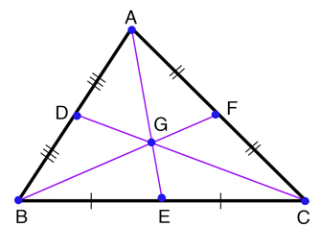
Subscribe to our ▶️ YouTube channel 🔴 for the latest videos, updates, and tips.
Point P is the centroid of △LMN. Find PN and QP.
Problem 1 :
Given that QN = 9
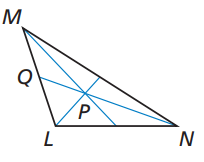
Solution :
|
NP = (2/3) NQ NP = (2/3)⋅ 9 NP = 6 |
QP = QN - NP QP = 9 - 6 QP = 3 |
Problem 2 :
Given that QN = 21
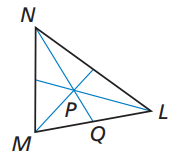
Solution :
|
NP = (2/3) NQ NP = (2/3) ⋅ 21 NP = 14 |
QP = QN - NP QP = 21 - 14 QP = 7 |
Problem 3 :
Given that QN = 30
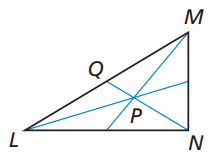
Solution :
|
NP = (2/3) NQ NP = (2/3) ⋅ 30 NP = 20 |
QP = QN - NP QP = 30 - 20 QP = 10 |
Problem 4 :
Given that QN = 42
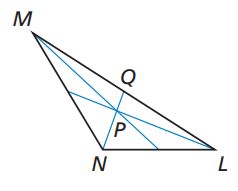
Solution :
|
NP = (2/3) NQ NP = (2/3) ⋅ 42 NP = 28 |
QP = QN - NP QP = 42 - 28 QP = 14 |
Point D is the centroid of △ABC. Find CD and CE.
Problem 5 :
Given that DE = 5, find CD and CE.
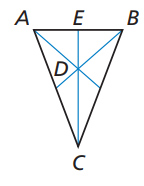
Solution :
CD = (2/3) CE
CD = (2/3) (CD + DE)
CD = (2/3) (CD + 5)
3CD = 2(CD + 5)
3CD = 2CD + 10
3CD - 2CD = 10
CD = 10
CE = CD + DE
CE = 10 + 5
CE = 15
Problem 6 :
Given that DE = 11, find CD and CE.
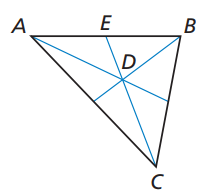
Solution :
CD = (2/3) CE
CD = (2/3) (CD + DE)
CD = (2/3) (CD + 11)
3CD = 2(CD + 11)
3CD = 2CD + 22
3CD - 2CD = 22
CD = 22
CE = CD + DE
CE = 22 + 11
CE = 33
Problem 7 :
Point G is the centroid of △ABC. BG = 6, AF = 12, and AE = 15. Find the length of the segment.
i) FC ii) BF iii) AG iv) GE
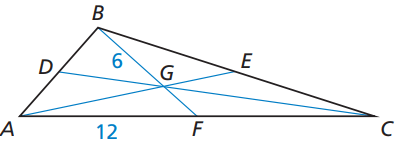
Solution :
Definition of centroid :
The point where three medians of the triangle intersect is known as centroid.
Accordingly definition of centroid, BF should be the median of AC.
i) AF = FC = 12
ii) BG = (2/3) ⋅ BF
6 = (2/3) ⋅ BF
18/2 = BF
BF = 9
iii) AG = (2/3) ⋅ AE
AG = (2/3) ⋅ 15
AG = 10
iv) AE = AG + GE
15 = 10 + GE
GE = 15 - 10
GE = 5
Point D is the centroid of △ABC. Use the given information to find the value of x.
Problem 8 :
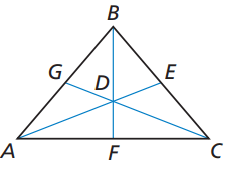
1) BD = 4x + 5 and BF = 9x
2) GD = 2x − 8 and GC = 3x + 3
3) AD = 5x and DE = 3x − 2
4) DF = 4x − 1 and BD = 6x + 4
Solution :
1) BD = 4x + 5 and BF = 9x
BD = (2/3) BF
(4x + 5) = (2/3) 9x
4x + 5 = 2(3x)
4x + 5 = 6x
6x - 4x = 5
2x = 5
x = 5/2
x = 2.5
2) GD = 2x − 8 and GC = 3x + 3
GD = (1/3) GC
2x - 8 = (1/3)(3x + 3)
2x - 8 = x + 1
2x - x = 1 + 8
x = 9
3) AD = 5x and DE = 3x − 2
AD = (2/3) AE
AE/3 = AD/2 ---(1)
DE = (1/3) AE
AE/3 = DE ----(2)
(1) = (2)
5x/2 = 3x - 2
5x = 6x - 4
5x - 6x = -4
-x = -4
x = 4
4) DF = 4x − 1 and BD = 6x + 4
DF = (1/3) BF
DF = BF/3 -----(1)
BD = (2/3) BF
BD/2 = BF/3 -----(2)
(1) = (2)
DF = BD/2
4x - 1 = (6x + 4)/2
2(4x - 2) = 6x + 4
8x - 6x = 4 + 4
2x = 8
x = 4
Recent Articles
-
Finding Range of Values Inequality Problems
May 21, 24 08:51 PM
Finding Range of Values Inequality Problems -
Solving Two Step Inequality Word Problems
May 21, 24 08:51 AM
Solving Two Step Inequality Word Problems -
Exponential Function Context and Data Modeling
May 20, 24 10:45 PM
Exponential Function Context and Data Modeling